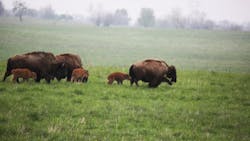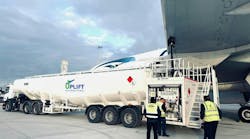Five bison calves were recently born at a wetland site in northeastern Illinois that was restored as part of the O'Hare Modernization Program (OMP) Wetlands Restoration Program. The calves, all born at Midewin National Tallgrass Prairie in Wilmington since April 23, are the newest additions to a bison herd that was introduced to the area in October of 2015 as part of an experiment to see how bison grazing improves the diversity of native vegetation during prairie restoration.
Located about one hour from Chicago, Midewin is one of six sites that is being restored with help from the Chicago Department of Aviation (CDA) under a program to replace poor-quality wetland areas on O'Hare's airfield with expanded, high quality wetlands in the Chicagoland region. Wetlands formerly located on O'Hare property needed to be removed to accommodate construction of new runways, taxiways and other airport infrastructure for the OMP. The overall intent of the OMP wetland mitigation program is to greatly improve the quality of the resource and benefits to wildlife, while offering additional value to the public by providing access that was not possible while the resources were at the Airport. Midewin is undergoing a transformation to restore a native tallgrass prairie ecosystem.
The public is invited to view the bison herd May 7 at Midewin. The event will be held in collaboration with the neighboring communities of Elwood and Wilmington in conjunction with their annual Route 66 "Red Carpet Corridor" event. For more information about the "Midewin Bison Expedition" event on Saturday, visit www.fs.usda.gov/midewin.
The CDA is partnering with Openlands, the U. S. Army Corps of Engineers, the Forest Preserve Districts of Cook, Will and DuPage counties, the Chicago Park District, Land & Water Resources, Inc., the U.S. Forest Service, the National Forest Foundation, the Wetlands Initiative and others to restore nearly 450 acres of wetlands and associated nature areas as mitigation for the impacts associated with the development of the OMP. Restoring wetlands in the Chicagoland region improves local water quality, absorbs carbon dioxide, provides valuable habitat for wildlife, and helps connect people with nature.
The creation of new wetlands is occurring at five other sites in northeastern Illinois, including: Van Vlissengen Prairie within the City of Chicago, Tinley Creek Forest Preserve in Cook County, Hadley Valley Preserve in Joliet, Messenger Woods Nature Preserve in Homer Township, and Deer Grove Forest Preserve--East in Palatine. These sites connect to existing wetlands and will enhance their size, quality and ecological function, multiplying the benefits of the wetlands restoration program several times over.




